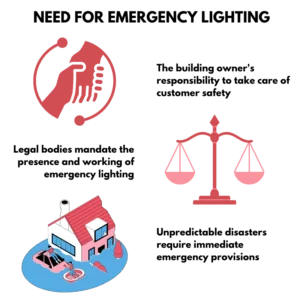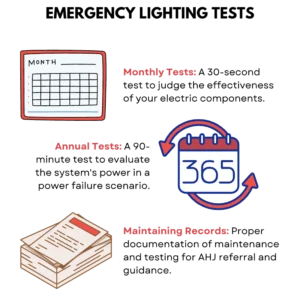Comprehensive Guide to Emergency Lighting: Ensuring Safety During Power Failure
Emergency lights precisely are what they explain to be: lights that need to work in emergencies. They are electric solutions designed to provide an illuminated exit path for people in buildings during an emergency, like a power outage during a fire hazard.
These lights need to effectively light egress paths (exit routes) so civilians in a building can get out as quickly and efficiently as possible. People also tend to panic more rapidly in situations with no lighting. Hence, an emergency light can decrease the tension and increase the chances of survival in a life-threatening emergency.
Emergency lighting includes but is not limited to escape lighting, open area lighting, standby lighting, exit signs, exit lights, and high-risk task lighting. Populated buildings must have two or more routes for escape during an emergency, and all of these routes must have emergency lighting and an exit sign.
The Need for Emergency Lighting
Social Responsibility
If you own a store or are the landlord of a residential building, you are responsible for ensuring the safety of individuals who visit or live in your property. It is the social responsibility of every citizen to ensure that no other person faces the possibility of harm due to their negligence.
Even if your building rooms need to be more significant for an entire emergency lighting route, emergency exits are the bare minimum that every building in the US must have.
Take, for example, a fire hazard in a supermarket. After the incident, if anyone had difficulty finding the emergency exits due to misplaced emergency lighting or if the fire alarm system did not go off properly, then the store owner could be heavily penalized financially or even jailed for not taking the safety of their customers seriously.

Not Only A Choice, A Requirement
Emergency lighting is a resource that must be present in a building according to codes and standards set by the NFPA (National Fire Protection Association), OSHA (Occupational Safety and Health Administration), and even the IBC (International Building Code).
Not meeting the requirements of these governmental organizations is seen as breaking the law and can lead to significant consequences that could affect the legality of your building and warrant immediate punishment through fines and even jail time.
Hence, it is crucial to ensure that emergency lighting is present where it needs to be and follows the proper rules set out by these life safety bodies.
Managing Life Safety During Natural Disasters
Natural disasters like earthquakes or cyclones are unavoidable acts of nature that can occur anytime. During these scenarios, people can get stuck in buildings and, at the moment, cannot contemplate what to do.
Emergency lighting and exit signs during a power outage can help guide these people to safety and save themselves from the harm of the disaster.
If you think emergency lighting is an unnecessary investment for commercial buildings in such situations, a study indicates that emergency lighting systems can increase the economy.
Operation of Emergency Lighting During Power Failures
Central and Self-Contained Emergency lights
Central Emergency Lighting Systems: These systems connect all lights to one primary backup power source, like an emergency generator. They use special fireproof wiring and automatically turn on when a building power failure occurs. Since all the lighting is connected to one entity, managing the system and replacing the backup power is easier on a larger scale.
Self-Contained Emergency Lighting Systems: These are battery-powered lighting systems in which every light source has its built-in backup battery within the same circuit. It is a cheaper solution for smaller buildings that cannot afford an entire central backup system and can effectively check each lighting piece.
Maintained and Non-Maintained Emergency Lights
Maintained Lights: Maintained lights are standard lighting that regularly runs on the main power supply for a building and, during a power failure, runs on the backup power of a building. These lights are always running but can switch between power supplies when needed. Most big populated buildings like malls and restaurants follow this system because they have too many lights to maintain on a full backup and hence only run the necessary lights in the case of an electricity problem.
Non-Maintained Lights: Non-maintained lights are lights that do not run on the main power supply but are activated when an electric failure occurs. These lights only run on backup power and do not have any other power source. Generally, these lights dim and preserve energy while also being less demanding in electric power so that they can operate for more extended periods in case of a prolonged emergency.

Application-Based Emergency Lighting
Emergency lighting can also be divided among the ways/scenarios in which they are used,
Escape Lighting: These lighting systems, composed of directional arrows and exit signs, are designed to guide people in the right direction of emergency exit routes.
High-Risk Task Lighting: This type of emergency lighting is required for buildings that require a specific amount of emergency light to complete emergency evacuation procedures before leaving. An example would be a water dam system, where the officers would need to shut down the system properly before they evacuated from the building.
Open Area Lighting: This type of lighting is used in open areas to provide a light source so that people don’t bump into each other or other objects in the environment during an emergency.
Standby Lighting: Standby lighting is the standard lighting source that is always needed, even in an emergency. A good example would be hospital room light sources, which need to operate precisely how they should, whether there’s a problem or not.
Emergency Lighting Function Test: Why It's Crucial
Checking the functioning of your emergency lighting systems is a frequent necessity, both because the law mandates it and because it is a fundamental part of life safety. Two frequent emergency lighting function tests have to be conducted on your emergency lighting,
Monthly Testing
Your emergency lighting system needs to be tested monthly by conducting the “push-button” test. This test consists of checking the emergency illumination of your lights for thirty seconds. On your system, there is a button that you can press to check if your system lights are still working. The test consists of holding this button for thirty seconds and ensuring that none of your lights dim or turn off during this period.
This test is crucial for maintaining your lighting bulbs’ effectiveness and ensuring that they work without flickering, dimming, or suddenly turning off. You need to do it for thirty seconds instead of just a few because some bulbs can turn on brightly for a few seconds but might not work correctly for an elongated period. Hence, more time ensures no invalid bulbs with initial illumination in the system.
Annual Testing
This type of annual test is conducted by turning on your emergency lights system, which runs on battery power for a minimum of 90 minutes and functions appropriately for that entire period. For the test, you must cut the original connection by throwing a circuit breaker or using a safe method. Then, it is checked if the system activates appropriately on its own and can run for a designated period of at least one and a half hours before it starts fluctuating.
The cruciality of this test is much more straightforward: it tests whether the system works in the situation of an actual power failure and ensures that it can last for a good period, similar to what a real power shortage would present. It also refreshes the system once yearly, ensuring your bulbs are effective when needed.
Download NFPA 101 handbook, Life Safety Code here
Maintaining Accurate Emergency Lighting Test Records
As vital as emergency lighting is for life safety, proper records must also be kept when emergency testing is done. This is because it is essential to understand the current status of your system when any test occurs, like which bulbs need looking at, the periods between different tests, and the frequency of how much the critical safety areas have been tested.
Not only this but like testing procedures, frequent documentation of your tests and your system must be done by the law. The International Fire Code states that the owner shall keep written records of any visual inspections and tests for checking by that specific region’s AHJ (Authority Having Jurisdiction).
Please see our comprehensive guide for a more in-depth look at maintaining smoke detector systems. If you ever need access to customizable checklists used during their maintenance and testing, check out our collection of 500+ checklists, which are instantly downloadable and usable.
Explore more templates
In the face of unexpected power outages or emergency situations, visibility is crucial for a safe evacuation. Emergency lighting is a vital component of any comprehensive safety plan.
Introducing our Emergency Lighting Function Test Checklist: a comprehensive tool designed to ensure the efficiency and compliance of emergency lighting systems
Ensure the reliable operation of emergency lighting during power failure with our checklist.
Elevate your safety standards with our Emergency Lighting Test Records template
Fire alarm system integration with emergency lighting refers to the coordination between a building’s fire alarm system and its emergency lighting system.
Tailored to meet your specific requirements, enabling you to manage
inspections and reports with greater detail and efficiency
ZenFire is a lot more customized to my business. Before I was using a generic app, I could not customize, like I do now."
